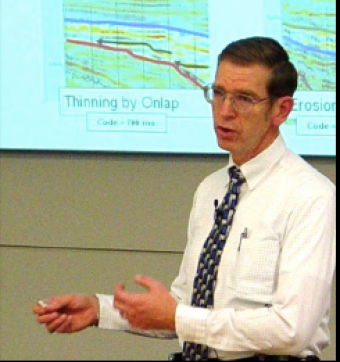Date: November 2, 2016 55min Advanced
Ideally, we would like to turn each seismic trace into an impedance trace or, going even further, into a velocity and density pseudo-log. That would allow us to predict rock properties in an interval of interest rather than acoustic properties at a major rock boundary. Variations in velocity and density at each seismic trace are better indicators of lateral changes in rock properties, such as thickness, net:gross or porosity.
Divide the class time into three (3) segments: (1) review the previous exercise, (2) introduce the lecture material, and (3) introduce the exercise presented here. The review of the previous exercise contains six (6) slides, and takes ~8 minutes to explain. The lecture introduced here has 25 slides, and takes ~40 minutes to explain. The introduction to the exercise here contains six (6) slides, and takes ~7 minutes to explain.
This exercise has the students compare a relative impedance trace through a well to an absolute impedance trace for the same location. In the process, they use the components of absolute impedance to finish the construction of the absolute impedance trace. During the exercise review, more comparisons are done using sections through the well location. This exercise should take about 20-30 minutes.
At the end of this lesson, students should be able to:

This course, based on teaching material from Dr. Fred Schroeder (formerly of Exxon/ExxonMobil), reflects on the geology and geophysics basics for the petroleum industry. General geology and basic geophysics are not required, but helpful with the material.
We encourage the reuse and dissemination of the material on this site as long as attribution is retained. To this end the material on this site, unless otherwise noted, is offered under Creative Commons Attribution (CC BY 4.0) license